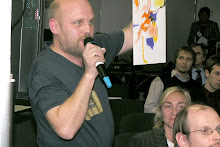In the terms of art theory one could call Tõnu Talve's art to be process oriented. This means that the way of making art is as important as the result. The process is as important as the result – one cannot really appreciate the result without seeing the process or the documentation of it on video. His friends the musicians play important roles, which give an additional fix of energy to his already impulsive way of painting.
Usually Talve makes a sort of pre painting for his shows, which is kind of calculated, but leaves space for improvisation. When the music starts he enters into a creative trance – with fast moves he grabs all sorts of painting attributes beginning from a simple brush to a marker. Seldom he looks at his work from a distance as usually is done by academic painters. He is so into the process that he does not necessarily know where he wants to end up. Only in the end he literally puts an end to his energetic painting moves by taking a marker and painting randomly some dots on the work. We could even say that he is an Estonian Jackson Pollock, whose painting process was documented. Talve has still not put his painting down horizontally nor walked on it while holding a brush and a can of paint, but you can see the same kind of spontaneity in his actions.As an art teacher he has also inspired his students to be as wild with paints as he is. His method while ignoring the dry academic approach of a realistic painting, of perspective and of composition helps to enhance the child's natural openness. It takes the pupil back to their early childhood where they took a pencil, a brush or clay and just express themselves and their emotions.
Tõnu Talve's last paintings are especially interesting. He has added a new component - elements of collage, which he uses in a sophisticated way. Many times I am left wondering whether they are painted or glued. Content wise has Tõnu Talve started to use citations from art history with respect to old masters in order to reflect upon on his own sub conscious thoughts. Even if I am not a professional psycho analyst, I sense a dilemma in his series called "Kaitseinglid", that is either a woman is a saint or a tempting decoy. All this is supported by his more and more expressive painting style, which in overall is not far from Edvard Munch.
Ants Juske, art critic, PhD.
Usually Talve makes a sort of pre painting for his shows, which is kind of calculated, but leaves space for improvisation. When the music starts he enters into a creative trance – with fast moves he grabs all sorts of painting attributes beginning from a simple brush to a marker. Seldom he looks at his work from a distance as usually is done by academic painters. He is so into the process that he does not necessarily know where he wants to end up. Only in the end he literally puts an end to his energetic painting moves by taking a marker and painting randomly some dots on the work. We could even say that he is an Estonian Jackson Pollock, whose painting process was documented. Talve has still not put his painting down horizontally nor walked on it while holding a brush and a can of paint, but you can see the same kind of spontaneity in his actions.As an art teacher he has also inspired his students to be as wild with paints as he is. His method while ignoring the dry academic approach of a realistic painting, of perspective and of composition helps to enhance the child's natural openness. It takes the pupil back to their early childhood where they took a pencil, a brush or clay and just express themselves and their emotions.
Tõnu Talve's last paintings are especially interesting. He has added a new component - elements of collage, which he uses in a sophisticated way. Many times I am left wondering whether they are painted or glued. Content wise has Tõnu Talve started to use citations from art history with respect to old masters in order to reflect upon on his own sub conscious thoughts. Even if I am not a professional psycho analyst, I sense a dilemma in his series called "Kaitseinglid", that is either a woman is a saint or a tempting decoy. All this is supported by his more and more expressive painting style, which in overall is not far from Edvard Munch.
Ants Juske, art critic, PhD.

No comments:
Post a Comment